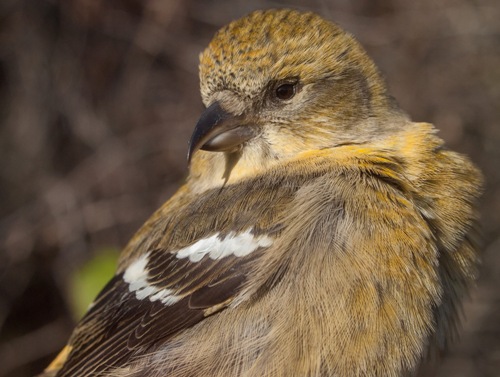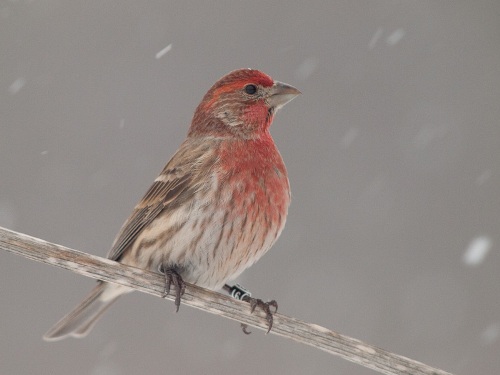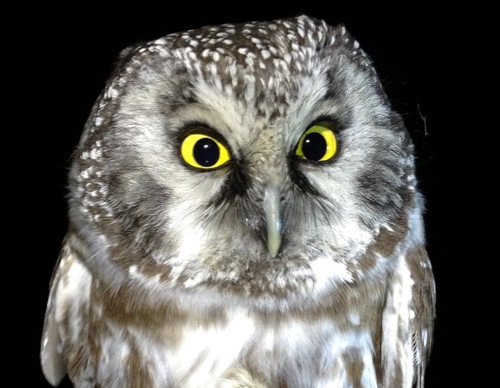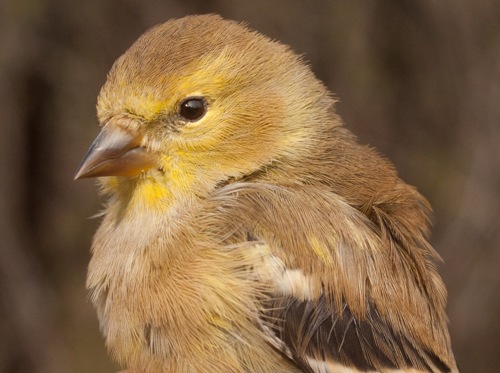|
October 31 - November 30, 2012 |
Welcome
to the McGill Bird Observatory weekly report.
Click here for a complete listing of our archives.
Comments or
questions are welcome at "mbo AT migrationresearch.org".
|
PICTURE
OF THE MONTH: |
|

The streak of "new" species in fall carried over into November, with this White-winged
Crossbill, the first of its kind banded at MBO, and species #111 overall.
(Photo by Simon Duval)

|
MBO
gratefully acknowledges the support provided for winter 2012-2013 by Bird Protection Quebec, in the form of bird seed to keep the MBO feeders stocked throughout the season.
|
|
|
|
THIS PERIOD |
THIS WINTER |
2012 TOTAL |
SITE TOTAL |
|
# birds (and species) banded |
277 (15) |
277 (15) |
5606 (93) |
41357 (111) |
|
# birds (and species) repeat |
100 (11) |
100 (11) |
1527 (62) |
7940 (70) |
|
# birds (and species) return |
16 (5) |
16 (5) |
242 (30) |
1203 (38) |
|
# species observed |
35 |
35 |
171 |
207 |
|
# net hours |
118.5 |
118.5 |
10166.6 |
69265.7 |
|
# birds banded / 100 net hours |
233.8 |
233.8 |
55.1 |
59.7 |
|
|
Note: table does not include nocturnal banding (owls) |
|
Banders-in-charge: Bob Barnhurst, Simon Duval, Gay Gruner
Assistants: Richard Beauchamp, Nicolas Bernier, Jean Demers, Liette Fortier, Louise Gagné, Barbara MacDuff, Chris Murphy, Yves Payette, Clémence Soulard, Monique Venne
Notes: Fall ended on a high note with an influx of surprises over the final week of the season, and November delivered more excitement. On November 7 we banded the first White-winged Crossbill in MBO`s history, becoming the 111th species on our cumulative list - and the third new addition in two weeks, counting the Red-bellied Woodpecker and Bohemian Waxwing in the final week of the Fall Migration Monitoring Program. Overall it was a busy November, with 277 birds banded over the span of 10 visits. The 35 species observed is a bit below the usual count for November, but we know from past years that the count increases throughout winter, sometimes in unexpected ways. Pine Grosbeak was the only species observed for the first time this year, bringing the count for 2012 to 171 species. Returns have been abundant all year, and there were another 16 this month. The Downy Woodpecker, 8 Black-capped Chickadees, and 3 American Goldfinches are likely all local residents that simply hadn't been caught during the Fall Migration Monitoring Program. However, the American Tree Sparrow and 3 Slate-colored Juncos were returns from previous years showing winter site fidelity - the sparrow back for its third winter in a row, and the juncos for the second, third, and fourth years respectively.

One of our colour-banded House Finches perching near the feeders.
(Photo by Simon Duval)
|
With the resumption of the winter program, we are again focusing effort on our feeder bird study. Once again, House Finch and American Goldfinch were among the most abundant species at MBO throughout November. We recaptured some of the individuals we banded last winter, and resighted some other House Finches wearing colour bands. We continued to deploy those bands on House Finches this month, but not on the goldfinches, as we realized after last winter's pilot project that they are simply too small to be effective. Full details of the project are at this link, and if you are lucky enough to spot one of our birds, we encourage you to share your sightings with us through our reporting page.

One of the four Boreal Owls banded at MBO in early November.
(Photo by Simon Duval)
|
While the finches were keeping us busy during the day, we also brought to a close another very successful owl banding season. By the end of the standard season on November 6, we had banded a record 235 Northern Saw-whet Owls, plus 10 individuals of four other species - including MBO's first ever Barred, Long-eared, and Boreal Owls. All four Boreal Owls came over the final two nights of the standard season - a welcome reward after setting up a secondary site to target the species this fall. Supplemental owl banding continued until November 20, but migration was clearly past its peak, with only 11 saw-whets in the first week after the end of the standard season, and 3 the week after. The owling season is summarized in section 7 of the MBO 2012 annual report.
This month’s top 10 [last year's November rank in brackets]
# individuals banded |
mean # individuals observed daily |
1. American Goldfinch (146) [3] |
1. Canada Goose (124) [1] |
2. House Finch (57) [1] |
2. European Starling (43) [3] |
3. Slate-colored Junco (24) [2] |
3. American Goldfinch (34) [10] |
4. Black-capped Chickadee (15) [9] |
4. American Robin (28) [5] |
5. Red-winged Blackbird (10) [6] |
5. Black-capped Chickadee (21) [8] |
6. White-throated Sparrow (6) [-] |
6. House Finch (16) [6] |
7. Northern Cardinal (4) [5] |
7. Red-winged Blackbird (14) [4] |
7. American Tree Sparrow (4) [4] |
8. Slate-colored Junco (12) [7] |
9. Common Redpoll (3) [-] |
9. Pine Siskin (9) [-] |
10. American Robin (2) [-] |
10. American Crow (5) [2] |
|
Goldfinches dominated the nets this month, accounting for over half of the birds banded. The number of House Finches was similar to last year at this time, and again much higher than in any other month. As usual, some late migrating juncos were banded in November, and this year the tail end of the chickadee migration also was apparent. Red-winged Blackbirds have been getting increasingly common at MBO in November, with the 10 individuals banded this year building on last year`s record of 8. Rounding out the top ten were smaller numbers of White-throated Sparrow, Northern Cardinal, American Tree Sparrow, Common Redpoll, and American Robin. The redpolls were the first banded in winter since 2010-2011, but followed up on the three banded in the final week of fall.
As usual, Canada Geese dominated the observations thanks to a flock of 800 on October 31, and smaller groups averaging a few dozen on other dates in November. European Starlings, American Robins, and Red-winged Blackbirds all were still seen in sizeable flocks on at least some dates. The influx of American Goldfinches at the nets was also reflected in the number observed daily, more than twice as many as in November 2011. The only species in the top ten this year that was different from last November was Pine Siskin (with Mallard dropping out).
|

One of the nearly 150 American Goldfinches banded this November.
(Photo by Simon Duval)
|





